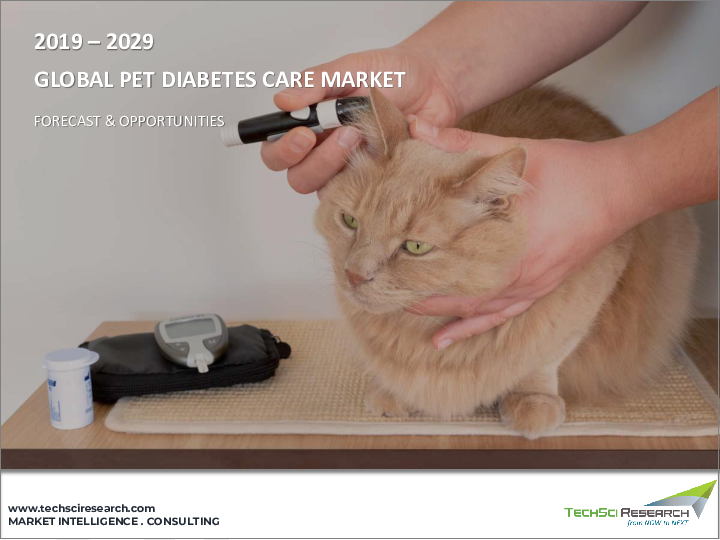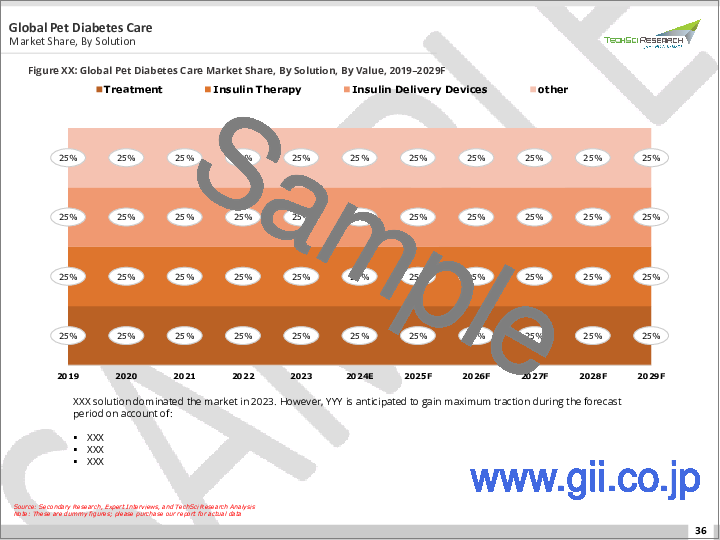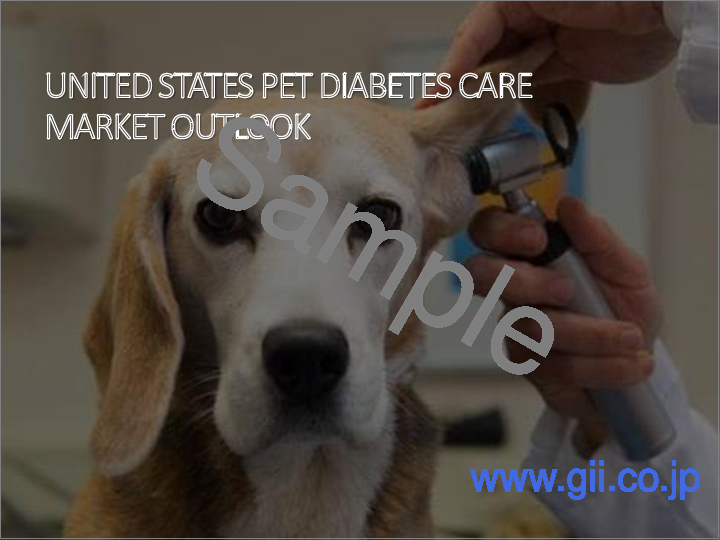|
|
市場調査レポート
商品コード
1370930
ペット糖尿病ケア市場-世界の産業規模、シェア、動向、機会、予測、2018~2028年、動物タイプ別、ソリューション別、流通チャネル別、地域別、競合Pet Diabetes Care Market - Global Industry Size, Share, Trends, Opportunity, and Forecast, 2018-2028 Segmented by Animal Type, By Solution, by Distribution Channel, and By Region, Competition |
||||||
カスタマイズ可能
|
|||||||
| ペット糖尿病ケア市場-世界の産業規模、シェア、動向、機会、予測、2018~2028年、動物タイプ別、ソリューション別、流通チャネル別、地域別、競合 |
|
出版日: 2023年10月03日
発行: TechSci Research
ページ情報: 英文 175 Pages
納期: 2~3営業日
|
- 全表示
- 概要
- 目次
世界のペット糖尿病ケア市場は、2022年に18億1,000万米ドルの評価額に達し、予測期間には大きな成長が見込まれており、年間平均成長率(CAGR)は6.92%と予測され、2028年までには27億米ドルに達する見込みです。
イントロダクション
糖尿病としても知られるペットの糖尿病は、主にペット、特に犬猫が罹患する慢性代謝疾患です。インスリンの分泌が不十分であったり、インスリンに対する反応が悪かったりするために、身体が血糖値を適切に調節できなくなることで発症します。インスリンは膵臓から分泌されるホルモンで、血糖値を調節し、細胞がブドウ糖をエネルギーとして利用するのを助けます。ペットの糖尿病の症状には、のどの渇きの増加、頻尿、食欲の増加、食欲があるにもかかわらず体重が減少する、無気力、衰弱などがあります。糖尿病を放置すると、ケトアシドーシス(生命を脅かす状態)、臓器障害、二次感染などの重篤な合併症を引き起こす可能性があります。
| 市場概要 | |
|---|---|
| 予測期間 | 2024~2028年 |
| 2022年の市場規模 | 18億1,000万米ドル |
| 2028年の市場規模 | 27億米ドル |
| CAGR 2023~2028年 | 6.92% |
| 急成長セグメント | 動物病院&クリニック |
| 最大市場 | 北米 |
主な市場促進要因
1.ペット飼育の増加:
世界のペットの飼育動向の高まり、特に犬猫の飼育動向は、糖尿病治療を含むペット医療・サービスの需要を促進しています。ペットの飼い主はペットの健康に対する意識が高まり、ペットを大切な家族の一員と考えるようになっています。このような意識の変化により、ペット医療への支出が増加し、糖尿病管理への投資意欲も高まっています。
2.専門ペットフードの入手可能性:
糖尿病を管理し血糖値をコントロールするために処方された専用ペットフードが、この市場セグメントの成長を牽引しています。これらの食事は利便性が高く、糖尿病のペット特有の栄養ニーズを満たし、治療を補完するように設計されています。
3.動物医学の進歩:
動物医学は、より優れた診断ツール、治療オプション、ペットの糖尿病のモニタリング技術など、著しい進歩を遂げています。こうした進歩により、糖尿病ペットに対するより効果的で専門的なケアが可能となっています。
主な市場課題:
1.治療費:
ペットの糖尿病管理には、長期にわたって費用がかかります。インスリン、特殊な食事、グルコース監視装置、合併症の緊急治療には高額な費用がかかります。そのため、ペットの飼い主によっては経済的に負担がかかり、包括的な治療を受ける余裕がなくなる可能性があります。
2.飼い主の時間的制約:
糖尿病のペットの状態を管理するには、血糖値のモニタリングや投薬など、一貫したタイムリーな介入が必要です。多忙な飼い主にとって、こうした厳格なルーチンを守ることは困難です。
主な市場動向:
1.意識の高まり:
ペットの糖尿病とその徴候や症状に対する認識が高まるにつれ、飼い主は適時に動物医師の治療を受け、専門的な製品や治療に投資するようになります。知識が豊富な飼い主は、ペットのケアについて十分な情報を得た上で意思決定を行うことができます。
セグメント別洞察
動物タイプ別洞察
世界の犬の世帯数の増加により、犬が市場を独占しています。近年、米国や欧州などの地域では、家庭のかなりの部分を犬が占めています。また、COVID-19の大流行により、精神的な支えのためにコンパニオンアニマルを飼う人が増えています。
ソリューション別洞察
治療、特にインスリン療法が市場の主要セグメントです。インスリン療法はペットの糖尿病治療のゴールドスタンダードと考えられており、食物から体内の他の臓器にグルコースを移動させる。注射器、注射針、送達ペンなど、インスリン送達機器のニーズは依然として高いです。
流通チャネル別洞察
動物病院とクリニックは、ペットの糖尿病ケア製品とサービスの主要な流通チャネルです。これらの施設は最先端の治療を提供し、ペットの医療用品を求める飼い主の最初の窓口となっています。動物医師やクリニックの数が増加していることも、このセグメントの成長に寄与しています。
地域別洞察
北米は世界のペット糖尿病ケア市場をリードしており、2022年には41%以上のシェアを占める。この優位性は、有力参入企業の存在、主要参入企業が採用する様々な拡大戦略、治療へのアクセシビリティの向上、より頻繁な診断、ペット数と支出の増加に起因します。さらに、この地域は動物医師免許を持つスタッフが常駐するクリニックの数が多く、市場の成長をさらに後押ししています。
目次
第1章 概要
第2章 調査手法
第3章 エグゼクティブサマリー
第4章 顧客の声
第5章 世界のペット糖尿病ケア市場展望
- 市場規模と予測
- 金額別
- 市場シェアと予測
- 動物タイプ別(犬、猫、その他)
- ソリューション別(治療薬、インスリン療法、インスリン送達デバイス、その他)
- 流通チャネル別(動物病院&クリニック、小売薬局、その他)
- 企業別(2022年)
- 地域別
- 市場マップ
第6章 北米のペット糖尿病ケア市場展望
- 市場規模・予測
- 金額別
- 市場シェアと予測
- 動物タイプ別
- ソリューション別
- 流通チャネル別
- 国別
- 北米:国別分析
- 米国ペット糖尿病ケア
- メキシコペット糖尿病ケア
- カナダ:ペット糖尿病ケア
第7章 欧州のペット糖尿病ケア市場展望
- 市場規模と予測
- 金額別
- 市場シェアと予測
- 動物タイプ別
- ソリューション別
- 流通チャネル別
- 国別
- 欧州:国別分析
- フランス
- ドイツ
- 英国
- イタリアの見通し
- スペイン
第8章 アジア太平洋のペット糖尿病ケア市場展望
- 市場規模と予測
- 金額別
- 市場シェアと予測
- 動物タイプ別
- ソリューション別
- 流通チャネル別
- 国別
- アジア太平洋:国別分析
- 中国
- インド
- 韓国
- 日本
- オーストラリア
第9章 南米のペット糖尿病ケア市場展望
- 市場規模と予測
- 金額別
- 市場シェアと予測
- 動物タイプ別
- ソリューション別
- 流通チャネル別
- 国別
- 南米:国別分析
- ブラジル
- アルゼンチン
- コロンビア
第10章 中東・アフリカのペット糖尿病ケア市場展望
- 市場規模・予測
- 金額別
- 市場シェアと予測
- 動物タイプ別
- ソリューション別
- 流通チャネル別
- 国別
- 中東・アフリカ:国別分析
- 南アフリカ
- サウジアラビア
- アラブ首長国連邦インスリン
第11章 市場力学
- 促進要因
- 課題
第12章 市場動向と発展
- 製品上市
- 合併と買収
第13章 PESTLE分析
第14章 ポーターのファイブフォース分析
- 業界内の競合
- 新規参入の可能性
- サプライヤーの力
- 顧客の力
- 代替品の脅威
第15章 競合情勢
- Merck Animal Health
- Zoetis Animal Health
- Becton Dickinson & Co Ltd
- Boehringer Ingelheim International Gmbh
- Trividia Health, Inc.
- Allison Medical, Inc.
- Ultimed, Inc.
- ACON Laboratories, Inc.
- I-SENS, Inc.
- Taidoc Technology Corporation
第16章 戦略的提言
The Global Pet Diabetes Care Market reached a valuation of USD 1.81 billion in 2022 and is poised for significant growth in the forecast period, with a projected Compound Annual Growth Rate (CAGR) of 6.92% and expected to reach USD 2.70 Billion through 2028.
Introduction:
Pet diabetes, also known as diabetes mellitus, is a chronic metabolic disorder that primarily affects pets, especially cats and dogs. It occurs when the body is unable to properly regulate blood glucose (sugar) levels due to either insufficient insulin production or poor response to insulin. Insulin is a hormone produced by the pancreas that helps regulate blood sugar and enables cells to utilize glucose for energy. Symptoms of pet diabetes include increased thirst, frequent urination, increased appetite, weight loss despite increased appetite, lethargy, and weakness. If left untreated, diabetes can lead to severe complications such as ketoacidosis (a life-threatening condition), organ damage, and secondary infections.
| Market Overview | |
|---|---|
| Forecast Period | 2024-2028 |
| Market Size 2022 | USD 1.81 Billion |
| Market Size 2028 | USD 2.70 Billion |
| CAGR 2023-2028 | 6.92% |
| Fastest Growing Segment | Veterinary Hospitals & Clinics |
| Largest Market | North America |
Key Market Drivers:
1. Increasing Pet Ownership:
The rising global trend of pet ownership, particularly for cats and dogs, is driving the demand for pet healthcare services, including diabetes care. Pet owners are becoming more aware of their pets' health and are increasingly considering them as integral family members. This shift in attitude has led to higher spending on pet healthcare and a willingness to invest in diabetes management.
2. Availability of Specialized Pet Food:
Specialized pet food formulated to manage diabetes and control blood sugar levels is driving the growth of this market segment. These diets offer convenience and are designed to complement medical treatment, meeting the unique nutritional needs of diabetic pets.
3. Advancements in Veterinary Medicine:
Veterinary medicine has made significant advancements, including better diagnostic tools, treatment options, and monitoring techniques for pet diabetes. These advancements allow for more effective and specialized care for diabetic pets.
Key Market Challenges:
1. Cost of Treatment:
Managing diabetes in pets can accumulate costs over time. Insulin, specialized diets, glucose monitoring devices, and emergency care for complications can be expensive. This can place financial strain on some pet owners, impacting their ability to afford comprehensive care.
2. Owner Time Constraints:
Managing a diabetic pet's condition requires consistent and timely interventions, including monitoring blood glucose levels and administering medications. Owners with busy schedules might find it challenging to adhere to these strict routines.
Key Market Trends:
1. Rising Awareness:
Increasing awareness of pet diabetes and its signs and symptoms prompts pet owners to seek timely veterinary care and invest in specialized products and treatments. Knowledgeable pet owners are better equipped to make informed decisions about their pets' care.
Segmental Insights:
Animal Type Insights:
Dogs dominate the market due to the increasing number of dog households worldwide. Dogs accounted for a significant portion of households in regions like the United States and Europe in recent years. The COVID-19 pandemic has also driven more people to adopt companion animals for emotional support.
Solution Insights:
Treatment, particularly insulin therapy, is the dominant segment in the market. Insulin therapy is considered the gold standard for diabetes treatment in pets, transferring glucose from food to other organs in the body. The need for insulin delivery equipment remains high, including syringes, needles, and delivery pens.
Distribution Channel Insights:
Veterinary hospitals and clinics are the primary distribution channel for pet diabetes care products and services. These facilities provide state-of-the-art treatment and are the first point of contact for pet owners seeking medical supplies for their pets. The increasing number of veterinarians and clinics contributes to this segment's growth.
Regional Insights:
North America leads the Global Pet Diabetes Care Market, with a share of over 41% in 2022. This dominance is attributed to the presence of prominent players, various expansion strategies employed by key players, increased accessibility to treatment, more frequent diagnostics, and a growing pet population and expenditure. Additionally, the region boasts a significant number of clinics staffed by licensed veterinarians, further supporting market growth.
Key Market Players
- Merck Animal Health
- Zoetis Animal Health
- Becton Dickinson & Co Ltd
- Boehringer Ingelheim International Gmbh
- Trividia Health, Inc.
- Allison Medical, Inc.
- Ultimed, Inc.
- ACON Laboratories, Inc.
- I-SENS, Inc.
- Taidoc Technology Corporation
Report Scope:
In this report, the Global Pet Diabetes Care Market has been segmented into the following categories, in addition to the industry trends which have also been detailed below.
Pet Diabetes Care Market, By Product:
- Dogs
- Cats
- others
Pet Diabetes Care Market, By Solution:
- Treatment
- Insulin Therapy
- Insulin Delivery Devices
- Others
Pet Diabetes Care Market, By Distribution Channel:
- Veterinary Hospitals & Clinics
- Retail Pharmacies
- Others
Global Pet Diabetes Care Market, By region:
- North America
- United States
- Canada
- Mexico
- Asia-Pacific
- China
- India
- South Korea
- Australia
- Japan
- Europe
- Germany
- France
- United Kingdom
- Spain
- Italy
- South America
- Brazil
- Argentina
- Colombia
- Middle East & Africa
- South Africa
- Saudi Arabia
- UAE
Competitive Landscape
- Company Profiles: Detailed analysis of the major companies present in the Global Pet Diabetes Care Market.
Available Customizations:
- Global Pet Diabetes Care Market report with the given market data, TechSci Research offers customizations according to a company's specific needs. The following customization options are available for the report:
Company Information
- Detailed analysis and profiling of additional market players (up to five).
Table of Contents
1. Product Overview
- 1.1. Market Definition
- 1.2. Scope of the Market
- 1.2.1. Markets Covered
- 1.2.2. Years Considered for Study
- 1.2.3. Key Market Segmentations
2. Research Methodology
- 2.1. Objective of the Study
- 2.2. Baseline Methodology
- 2.3. Key Industry Partners
- 2.4. Major Association and Secondary Sources
- 2.5. Forecasting Methodology
- 2.6. Data Triangulation & Validation
- 2.7. Assumptions and Limitations
3. Executive Summary
- 3.1. Overview of the Market
- 3.2. Overview of Key Market Segmentations
- 3.3. Overview of Key Market Players
- 3.4. Overview of Key Regions/Countries
- 3.5. Overview of Market Drivers, Challenges, Trends
4. Voice of Customer
5. Global Pet Diabetes Care Market Outlook
- 5.1. Market Size & Forecast
- 5.1.1. By Value
- 5.2. Market Share & Forecast
- 5.2.1. By Animal Type (Dogs, Cats, others)
- 5.2.2. By Solution (Treatment, Insulin Therapy, Insulin Delivery Devices, other)
- 5.2.3. By Distribution Channel (Veterinary Hospitals & Clinics, Retail Pharmacies, others)
- 5.2.4. By Company (2022)
- 5.2.5. By Region
- 5.3. Market Map
6. North Pet Diabetes Care Market Outlook
- 6.1. Market Size & Forecast
- 6.1.1. By Value
- 6.2. Market Share & Forecast
- 6.2.1. By Animal Type
- 6.2.2. By Solution
- 6.2.3. By Distribution Channel
- 6.2.4. By Country
- 6.3. North America: Country Analysis
- 6.3.1. United States Pet Diabetes Care Market Outlook
- 6.3.1.1. Market Size & Forecast
- 6.3.1.1.1. By Value
- 6.3.1.2. Market Share & Forecast
- 6.3.1.2.1. By Animal Type
- 6.3.1.2.2. By Solution
- 6.3.1.2.3. By Distribution Channel
- 6.3.1.1. Market Size & Forecast
- 6.3.2. Mexico Pet Diabetes Care Market Outlook
- 6.3.2.1. Market Size & Forecast
- 6.3.2.1.1. By Value
- 6.3.2.2. Market Share & Forecast
- 6.3.2.2.1. By Animal Type
- 6.3.2.2.2. By Solution
- 6.3.2.2.3. By Distribution Channel
- 6.3.2.1. Market Size & Forecast
- 6.3.3. Canada Pet Diabetes Care Market Outlook
- 6.3.3.1. Market Size & Forecast
- 6.3.3.1.1. By Value
- 6.3.3.2. Market Share & Forecast
- 6.3.3.2.1. By Animal Type
- 6.3.3.2.2. By Solution
- 6.3.3.2.3. By Distribution Channel
- 6.3.3.1. Market Size & Forecast
- 6.3.1. United States Pet Diabetes Care Market Outlook
7. Europe Pet Diabetes Care Market Outlook
- 7.1. Market Size & Forecast
- 7.1.1. By Value
- 7.2. Market Share & Forecast
- 7.2.1. By Animal Type
- 7.2.2. By Solution
- 7.2.3. By Distribution Channel
- 7.2.4. By Country
- 7.3. Europe: Country Analysis
- 7.3.1. France Pet Diabetes Care Market Outlook
- 7.3.1.1. Market Size & Forecast
- 7.3.1.1.1. By Value
- 7.3.1.2. Market Share & Forecast
- 7.3.1.2.1. By Animal Type
- 7.3.1.2.2. By Solution
- 7.3.1.2.3. By Distribution Channel
- 7.3.1.1. Market Size & Forecast
- 7.3.2. Germany Pet Diabetes Care Market Outlook
- 7.3.2.1. Market Size & Forecast
- 7.3.2.1.1. By Value
- 7.3.2.2. Market Share & Forecast
- 7.3.2.2.1. By Animal Type
- 7.3.2.2.2. By Solution
- 7.3.2.2.3. By Distribution Channel
- 7.3.2.1. Market Size & Forecast
- 7.3.3. United Kingdom Pet Diabetes Care Market Outlook
- 7.3.3.1. Market Size & Forecast
- 7.3.3.1.1. By Value
- 7.3.3.2. Market Share & Forecast
- 7.3.3.2.1. By Animal Type
- 7.3.3.2.2. By Solution
- 7.3.3.2.3. By Distribution Channel
- 7.3.3.1. Market Size & Forecast
- 7.3.4. Italy Pet Diabetes Care Outlook
- 7.3.4.1. Market Size & Forecast
- 7.3.4.1.1. By Value
- 7.3.4.2. Market Share & Forecast
- 7.3.4.2.1. By Animal Type
- 7.3.4.2.2. By Solution
- 7.3.4.2.3. By Distribution Channel
- 7.3.4.1. Market Size & Forecast
- 7.3.5. Spain Pet Diabetes Care Market Outlook
- 7.3.5.1. Market Size & Forecast
- 7.3.5.1.1. By Value
- 7.3.5.2. Market Share & Forecast
- 7.3.5.2.1. By Animal Type
- 7.3.5.2.2. By Solution
- 7.3.5.2.3. By Distribution Channel
- 7.3.5.1. Market Size & Forecast
- 7.3.1. France Pet Diabetes Care Market Outlook
8. Asia-Pacific Pet Diabetes Care Market Outlook
- 8.1. Market Size & Forecast
- 8.1.1. By Value
- 8.2. Market Share & Forecast
- 8.2.1. By Animal Type
- 8.2.2. By Solution
- 8.2.3. By Distribution Channel
- 8.2.4. By Country
- 8.3. Asia-Pacific: Country Analysis
- 8.3.1. China Pet Diabetes Care Market Outlook
- 8.3.1.1. Market Size & Forecast
- 8.3.1.1.1. By Value
- 8.3.1.2. Market Share & Forecast
- 8.3.1.2.1. By Animal Type
- 8.3.1.2.2. By Solution
- 8.3.1.2.3. By Distribution Channel
- 8.3.1.1. Market Size & Forecast
- 8.3.2. India Pet Diabetes Care Market Outlook
- 8.3.2.1. Market Size & Forecast
- 8.3.2.1.1. By Value
- 8.3.2.2. Market Share & Forecast
- 8.3.2.2.1. By Animal Type
- 8.3.2.2.2. By Solution
- 8.3.2.2.3. By Distribution Channel
- 8.3.2.1. Market Size & Forecast
- 8.3.3. South Korea Pet Diabetes Care Market Outlook
- 8.3.3.1. Market Size & Forecast
- 8.3.3.1.1. By Value
- 8.3.3.2. Market Share & Forecast
- 8.3.3.2.1. By Animal Type
- 8.3.3.2.2. By Solution
- 8.3.3.2.3. By Distribution Channel
- 8.3.3.1. Market Size & Forecast
- 8.3.4. Japan Pet Diabetes Care Market Outlook
- 8.3.4.1. Market Size & Forecast
- 8.3.4.1.1. By Value
- 8.3.4.2. Market Share & Forecast
- 8.3.4.2.1. By Animal Type
- 8.3.4.2.2. By Solution
- 8.3.4.2.3. By Distribution Channel
- 8.3.4.1. Market Size & Forecast
- 8.3.5. Australia Pet Diabetes Care Market Outlook
- 8.3.5.1. Market Size & Forecast
- 8.3.5.1.1. By Value
- 8.3.5.2. Market Share & Forecast
- 8.3.5.2.1. By Animal Type
- 8.3.5.2.2. By Solution
- 8.3.5.2.3. By Distribution Channel
- 8.3.5.1. Market Size & Forecast
- 8.3.1. China Pet Diabetes Care Market Outlook
9. South America Pet Diabetes Care Market Outlook
- 9.1. Market Size & Forecast
- 9.1.1. By Value
- 9.2. Market Share & Forecast
- 9.2.1. By Animal Type
- 9.2.2. By Solution
- 9.2.3. By Distribution Channel
- 9.2.4. By Country
- 9.3. South America: Country Analysis
- 9.3.1. Brazil Pet Diabetes Care Market Outlook
- 9.3.1.1. Market Size & Forecast
- 9.3.1.1.1. By Value
- 9.3.1.2. Market Share & Forecast
- 9.3.1.2.1. By Animal Type
- 9.3.1.2.2. By Solution
- 9.3.1.2.3. By Distribution Channel
- 9.3.1.1. Market Size & Forecast
- 9.3.2. Argentina Pet Diabetes Care Market Outlook
- 9.3.2.1. Market Size & Forecast
- 9.3.2.1.1. By Value
- 9.3.2.2. Market Share & Forecast
- 9.3.2.2.1. By Animal Type
- 9.3.2.2.2. By Solution
- 9.3.2.2.3. By Distribution Channel
- 9.3.2.1. Market Size & Forecast
- 9.3.3. Colombia Pet Diabetes Care Market Outlook
- 9.3.3.1. Market Size & Forecast
- 9.3.3.1.1. By Value
- 9.3.3.2. Market Share & Forecast
- 9.3.3.2.1. By Animal Type
- 9.3.3.2.2. By Solution
- 9.3.3.2.3. By Distribution Channel
- 9.3.3.1. Market Size & Forecast
- 9.3.1. Brazil Pet Diabetes Care Market Outlook
10. Middle East and Africa Pet Diabetes Care Market Outlook
- 10.1. Market Size & Forecast
- 10.1.1. By Value
- 10.2. Market Share & Forecast
- 10.2.1. B By Animal Type
- 10.2.2. By Solution
- 10.2.3. By Distribution Channel
- 10.2.4. By Country
- 10.3. MEA: Country Analysis
- 10.3.1. South Africa Pet Diabetes Care Market Outlook
- 10.3.1.1. Market Size & Forecast
- 10.3.1.1.1. By Value
- 10.3.1.2. Market Share & Forecast
- 10.3.1.2.1. By Animal Type
- 10.3.1.2.2. By Solution
- 10.3.1.2.3. By Distribution Channel
- 10.3.1.1. Market Size & Forecast
- 10.3.2. Saudi Arabia Pet Diabetes Care Market Outlook
- 10.3.2.1. Market Size & Forecast
- 10.3.2.1.1. By Value
- 10.3.2.2. Market Share & Forecast
- 10.3.2.2.1. By Type
- 10.3.2.2.2. By Material
- 10.3.2.2.3. By Product
- 10.3.2.2.4. By Application
- 10.3.2.2.5. By Distribution Channel
- 10.3.2.2.6. By End User
- 10.3.2.1. Market Size & Forecast
- 10.3.3. UAE Insulin Pet Diabetes Care Market Outlook
- 10.3.3.1. Market Size & Forecast
- 10.3.3.1.1. By Value
- 10.3.3.2. Market Share & Forecast
- 10.3.3.2.1. By Animal Type
- 10.3.3.2.2. By Solution
- 10.3.3.2.3. By Distribution Channel
- 10.3.3.1. Market Size & Forecast
- 10.3.1. South Africa Pet Diabetes Care Market Outlook
11. Market Dynamics
- 11.1. Drivers
- 11.2. Challenges
12. Market Trends & Developments
- 12.1. Recent Developments
- 12.2. Product Launches
- 12.3. Mergers & Acquisitions
13. PESTLE Analysis
14. Porter's Five Forces Analysis
- 14.1. Competition in the Industry
- 14.2. Potential of New Entrants
- 14.3. Power of Suppliers
- 14.4. Power of Customers
- 14.5. Threat of Substitute Product
15. Competitive Landscape
- 15.1. Business Overview
- 15.2. Company Snapshot
- 15.3. Products & Services
- 15.4. Financials (In case of listed companies)
- 15.5. Recent Developments
- 15.6. SWOT Analysis
- 15.6.1. Merck Animal Health
- 15.6.2. Zoetis Animal Health
- 15.6.3. Becton Dickinson & Co Ltd
- 15.6.4. Boehringer Ingelheim International Gmbh
- 15.6.5. Trividia Health, Inc.
- 15.6.6. Allison Medical, Inc.
- 15.6.7. Ultimed, Inc.
- 15.6.8. ACON Laboratories, Inc.
- 15.6.9. I-SENS, Inc.
- 15.6.10. Taidoc Technology Corporation






